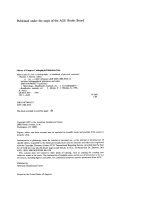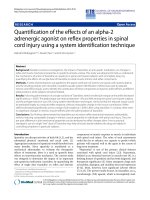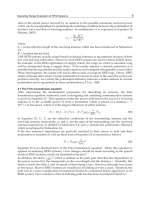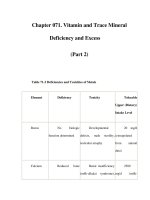Mineral identification 2
Bạn đang xem bản rút gọn của tài liệu. Xem và tải ngay bản đầy đủ của tài liệu tại đây (1.27 MB, 45 trang )
INDUSTRIAL MINERAL
CONCENTRATION TECNOLOGIES
Prof.Dr. Muammer KAYA
Osmangazi University
Eskisehir-TURKEY
2007
From raw material
To Final Product
Principles of Flotation
Flotation concentration method utilizes
the differences in physico chemical
surface properties of particles.
Hydrophobic (water repellent) particles
float with air bubbles to form a froth.
Wetted hydrophilic particles sink.
Hydrophobicity increases with the
contact angle btw particles and bubbles.
Chemical reagents are used in flotation.
Flotation is a selective separation
process.
Flotation is the most important and
versatile mineral processing technique
used in mining industry.
APPLICATION OF FLOTATION
• Flotation can be successfully applied to both
metallic and industrial minerals given below
for removing impurities and improving
quality:
• Apatite/Phosphate, Barite, Calcite, Dolomite,
Feldspar, Fluorspar, Graphite, Iron Ore,
Kyanite, Magnesite, Monazite, Potash,
Pyrochlore, Quartz/Silica Sand, Scheelite etc.
MECHANICAL FLOTATION MACHINE
Froth flotation is achieved when particles are separated based on their
surface potential. Hydrophobic particles are recovered to the froth,
whereas hydrophilic particles are discharged with the tailings stream.
PHOSPHATE MINERALS
•
•
•
•
•
•
Phosphate minerals are those minerals that contain the tetrahedrally coordinated
phosphate (PO43-) anion along with the freely substituting arsenate (AsO43-) and vanadate
(VO43-). Chlorine (Cl-), fluorine (F-), and hydroxide (OH-) anions also fit into the crystal
structure.
The phosphate class of minerals is a large and diverse group, however, only a few species
are relatively common.
Examples include:
triphylite Li(Fe,Mn)PO4
monazite (Ce,La,Y,Th)PO4
Apatite group Ca5(PO4)3(F,Cl,OH)
–
–
–
•
•
•
•
•
•
•
•
•
•
hydroxylapatite Ca5(PO4)3OH
fluorapatite Ca5(PO4)3F
chlorapatite Ca5(PO4)3Cl
pyromorphite Pb5(PO4)3Cl
vanadinite Pb5(VO4)3Cl
erythrite Co3(AsO4)2·8H2O
amblygonite LiAlPO4F
lazulite (Mg,Fe)Al2(PO4)2(OH)2
wavellite Al3(PO4)2(OH)3·5H2O
turquoise CuAl6(PO4)4(OH)8·5H2O
autunite Ca(UO2)2(PO4)2·10-12H2O
carnotite K2(UO2)2(VO4)2·3H2O
phosphophyllite Zn2(Fe,Mn)(PO4)2•4H2O
PO43- anion
DEPOSITS
• Rock phosphate can also be found on USA, Egypt,
Israel, Morocco, Navassa Island, Tunisia, Togo, S.
Arabia and Jordan have large phosphate mining
industries as well.
USE OF PHOSPHATE
•
•
•
•
•
•
•
Phosphates were once commonly used in laundry detergent in the form trisodium
phosphate (TSP), but, because of algae boom-bust cycles tied to emission of phosphates
into watersheds, phosphate detergent sale or usage is restricted in some areas.
In agriculture, phosphate is one of the three primary plant nutrients, and it is a component
of fertilizers. Rock phosphate is quarried from phosphate beds in sedimentary rocks. In
former times, it was simply crushed and used as is, but the crude form is now used only in
organic farming. Normally, it is chemically treated to make superphosphate,
triple superphosphate, or ammonium phosphates, which have higher concentration of
phosphate and are also more soluble, therefore more quickly usable by plants.
Fertilizer grades have three numbers; the first is the available nitrogen, the second is the
available phosphate (expressed on a P2O5 basis), and the third is the available potash
(expressed on a K2O basis). Thus a 10-10-10 fertilizer would contain ten percent of each,
with the remainder being filler.
Surface runoff of phosphates from excessively-fertilized farmland can be a cause of
phosphate pollution, leading to eutrophication (nutrient enrichment), algal bloom, and
consequent oxygen deficit. This can lead to anoxia for fish and other aquatic organisms in
the same manner as phosphate-based detergents.
Phosphate compounds are occasionally added to the public drinking water supply to
counter plumbosolvency.
The food industry uses phosphates to perform several different functions. For example, in
meat products, it solubilizes the protein. This improves its water-holding ability and
increases its moistness and succulence. In baked products, such as cookies and
crackers, phosphate compounds can act as part of the leavening system when it reacts
with an alkalai, usually sodium bicarbonate (baking soda).
Phosphate minerals are often used for control of rust and prevention of corrosion on
ferrous materials, applied with electrochemical conversion coatings
PHOSPHATE FLOTATION
•
•
•
•
•
•
•
Collophane, the principal phosphate mineral occuring in the phospate
deposits of the Southeastern US, floats readily with crude fatty acids
and soaps, fuel oil and soda ash, caustic soda or amonia.
“Double flotation” method is used in US Florida plants by using both
fatty acid and amine types of collectors.
“Single flotation” is employed at N.Africa and Middle Eastern phosphate
operations by using either a fatty acid or an amine type of collector.
Cytec’s Aero 727, 727J and 728 promoters have been successfully used
where only fatty acid float approach is practiced.
Cytec’s Aero 8651 fatty amine promer is utilized in operations running
an amine float.
In the reverse flotation, Cytec Acco-Phos 950 depressant (20-100 g/t)
minimizes phosphate loses into the silica froth product using amine
collectors.
In the treatment of sedimentary pebble phosphates, Aero 845 can be
used in conjuction with fatty acids.
US DOUBLE PHOSPHATE FLOTATION
-
FEED
Slimes (-10 µ)
+
Desliming
(Hydrocyclones)
conditioner
PhosphateSilica Sep. Flot
70%S
F
pH=9-9.5
T
Rougher fl.
Silica (final tails)
C
(sodaash/NaOH)
Conditioning with
Crude fatty oil
Silica Removal Reverse
Flot.
H2SO4+washing
Fuel-oil
to remove reagents
pH=6.5-7
Fatty/ether amine
Cleaner fl.
Phosphate
Conc.
conditioner
Silica (gangue)
LIME STONE/CALCITE
• Limestone is a sedimentary rock composed
largely of the mineral calcite (
calcium carbonate: CaCO3). l
• Limestone often contains variable amounts
of silica in the form of chert or flint, as well
as varying amounts of clay, silt and sand as
disseminations, nodules, or layers within
the rock.
USES OF LIMESTONE
Iron impregnations in limestone
•
•
•
•
•
•
•
•
•
•
The manufacture of quicklime (calcium oxide) and slaked lime
(calcium hydroxide);
Cement and mortar;
Pulverized limestone is used as a soil conditioner to neutralize
acidic soil conditions;
Crushed for use as aggregate—the solid base for many roads;
Limestone is especially popular in architecture as building
stone/ material;
Geological formations of limestone are among the best
petroleum reservoirs;
As a reagent in desulfurizations;
Glass making;
Toothpaste;
Added to bread as a source of calcium
LIME STONE/CALCITE
(CaCO3) FLOTATION
•
•
•
•
•
•
•
Natural limestone/calcite deposits contain various types of silicates
and graphite impurities.
For applications like paper fillers the calcite has to have a low grade of
abrasive silicates as well as a high brightness.
Even very low amounts of graphite is detrimental to the brightness.
Beneficiation of limestone by froth flotation utilizing Aero 845
promoter can be simple process.
Limestone is floated with/without prior desliming with the emulsion of
Aero 845 and number 5 fuel oil.
Silicates can be depressed by Na2SiO3 (500-1000 g/t).
Compared to fatty acids, Aero 845 promoter (Pet. Sulphonate type
anionic collector) offer the advantage of better product control at a
saving in total collector usage.
Sparingly soluble salts flot.
Complete flot.
100
R=100%
80
pH:6- 9
60
fluorite
calcite
apatite
40
20
R=0%
No flot.
0
10
-06
10
-05
10
-04
10
-03
3
sodium oleate concentration, mol/dm
Mole/l
Calcite flot. recovery depends on NaOl concentration and HC chain
length of the collector. In general, when the collector length of the HC
chain is increased, the concentration of collector necessary for
flotation is reduced.
GRAPHITE CONCENTRATION
TECHNOLOGY
• Graphite is one of the allotropes of carbon.
Unlike diamond, graphite is an
electrical conductor.
• Graphite holds the distinction of being the
most stable form of solid carbon ever
discovered.
• It may be considered the highest grade of
coal, just above anthracite and alternatively
called meta-anthracite, although it is not
normally used as fuel because it is hard to
ignite.
CLASSIFICATION OF GRAPHITE
• There are three principal types of natural graphite,
each occurring in different types of ore deposit:
• (1) Crystalline flake graphite (53%) occurs as
isolated, flat, plate-like particles with hexagonal
edges if unbroken and when broken the edges can
be irregular or angular (Madagascar-open pit, 410950 $/t)
• (2) Amorphous graphite occurs as fine particles
(Mexico-Underground mines, 240-260 $/t)
• (3) Lump graphite (also called vein graphite) occurs
in fissure veins or fractures and appears as massive
platy intergrowths of fibrous or acicular crystalline
aggregates, and is probably hydrothermal in origin
(Sri Lanka-Underground mines).
USE AREAS OF GRAPHITE
MAJOR USE AREAS
REFRACTORIES
(High temperature applicationsMelting Point 3927°C)
Coarse flakes
Graphite crucibles
Carbon-magnesite/alumina bricks (95-99% C)
Monolitics (gunning and ramming mixtures)
Continuous casting ware (nozzles, troughs)
STEEL MAKING
Amorphous or fine flaked
Carbon rising in molten steel
Lubricating dies during hot metal extrution
EXPANDED GRAPHITE
Flakes
Made from flake graphite using chromic acid
sulphuric acids to produce foils
Can be used to insulate molten metal in
ladle, fuel cells and heat sinks for laptop
computer
MINOR USE AREAS
BRIKE LINING/SHOES FOR HEAVY
TRUCKS
FOUNDRY FACING and LUBRICANTS
PENCIL LEAD
Zn-C BATTERIES
ELECTRIC MOTOR BRUSHES
GRAPHITE(CARBON) FIBERS/NANOTUBES
Made from amourphous or fine flakes
Substitute for asbestos
Amourphous or fine flakes are used
High temp. dry lubricant
Powder graphite+clay
Powdered fine flaked graphite
Powder graphite
Reinforced/antistatic/conductive plastics/
concreates/rubbers
IMPURITIES and PROPERTIES
• Minerals associated with graphite include quartz,
calcite, micas, iron meteorites, and tourmalines.
• In 2005, world natural graphite production was
1.05 million t and China was the top producer of
graphite with about 80% world share followed by
India and Brazil.
• Graphite has various characteristics. Thin flakes
are flexible but inelastic, the mineral can leave
black marks on hands and paper, it is
diamagnetic, adsorbant, conducts electricity, and
displays superlubricity. Its best field indicators
are softness, luster, density and streak.
GRAPHITE BENEFICIATION METHODS
• Vary from a complex flotation at Europe and USA mills to
simply hand sorting and screening with/without milling of highgrade ores in Sri Lanka.
• Certain soft flake-type graphite ores, (like in Madagascar) need
no primary crushing and grinding.
• GRAPHITE MILLING ONLY
•
Graphite can be ground to a fine powder for use as a slurry in oil drilling; in
zirconium silicate, sodium silicate and isopropyl alcohol coatings for
foundry molds; and for calcined petroleum coke, which is used as a carbon
raiser in the steel industry.
•
Rough graphite is typically ground and packaged at a graphite mill. Since
the Work Index of graphite is high, power consumption during grinding will
be high.
•
Environmental impacts from graphite mills consist of air pollution
including fine particulate exposure of workers and also soil contamination
from powder spillages leading to heavy metals contaminations of soil. Dust
masks are normally worn by workers during the production process to
avoid worker exposure to the fine airborne graphite and zircon silicate.
GRAPHITE FLOTATION
•
Since graphite is naturally hydrophobic (i.e. floats easily),
impurites can easily be removed by direct flotation process.
•
Flotation process can be applied to low carbon and high silica
containing graphite ores.
1. DESLIMING STEP for removing clay minerals,
2. ROUGHER FLOTATION to produce a concentrate with 60-70% C.
3. REGRINDING+CLEANER FLOTATION to reach 85% C.
4. SCREENING to produce 75-95%C.
•
•
•
•
•
- 0.5 mm graphite can be floated using fuel-oil/kerosene as the
promoter and pine-oil/F-77/MIBC as frother at natural pH. Na2SiO3/HF
can be used as silicate depressant.
IRON ORES
Brazillian hematite
• Iron ores are rocks and minerals from which
metallic iron can be economically extracted.
The ores are usually rich in iron oxides and
vary in color from dark grey to rusty red. The
iron itself is usually found in the form of
magnetite (Fe3O4), hematite (Fe2O3), limonite or
siderite. Hematite ores containing 66% Fe can
be fed directly into iron making blast furnaces.
Iron ore is the raw material used to make
pig iron, which is one of the main raw
materials to make steel. 98% of the mined iron
ore is used to make steel.
Consumption and economics
•
Iron is the world's most commonly used metal. It is used
primarily in structural engineering applications, automobiles,
and general industrial applications (machinery).
•
Iron-rich rocks are common worldwide, but ore-grade
commercial mining operations are dominated by few countries.
•
World production averages one billion metric tons of raw ore
annually. The world's largest producer of iron ore is the
Brazilian mining corporation CVRD, followed by Australian
company BHP Billiton and the Anglo-Australian
Rio Tinto Group.
•
China, Japan and S. Korea are currently the largest consumer
of iron ore/steel. which translates to be the world's largest steel
producing country.
LOW GRADE IRON ORE
BENEFICIATION
• Due to the high density of hematite (5.3)
relative to silicates (2.7), beneficiation usually
involves a combination of crushing and
milling as well as heavy liquid separation.
• This is achieved by passing the finely crushed
ore over a bath of solution containing
bentonite or other agent which increases the
density of the solution. When the density of
the solution is properly calibrated, the
hematite will sink and the silicate mineral
fragments will float and can be removed.
FLOTATION OF IRON ORE
•
•
•
Due to increased demand for iron ore products low in silica and
phosphorous plus increased world competition, quality
considerations have become more and more important.
Dephosphorization of iron ores is necessary.
The results obtained in plant operations vary, depending on ore type
and the process.
•
Direct flotation of iron ores was practiced for many years using
Aero899R promoter (1-2 kg/t) along with number 5 fuel oil at pH 3-5
adjusted by H2SO4 following high solids conditioning.
•
Reverse flotation of silica with etheramine collectors+frother
(Aerofroth or Oreprep) has been the traditional route for many years to
produce a final iron ore concentrate. While removing silica from the
iron ore, fine iron particles should not excessively lost.
FINE IRON ORE PELLETS
Iron ore fines
and flotation
concentrates
should be
pelletized with
bentonite before
being charged
into the blast
furnace to
produce pig-iron
which is used in
steel production.
Iron pellets









